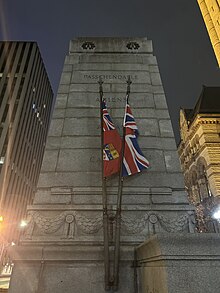Old City Hall Cenotaph, Toronto
The Old City Hall Cenotaph is a cenotaph located at the front steps of Old City Hall in Toronto, Ontario, Canada.[2]
Originally built after World War I to commemorate Torontonians who lost their lives in services for Canada, the memorial also commemorates those who died in World War II and the Korean War.[3] It was modelled on The Cenotaph at Whitehall in London, England, constructed using granite cut from the Canadian Shield, and unveiled on November 11, 1925.[4] The City of Toronto lists the artists as "Ferguson/Pomphrey",[5] which were an architectural firm located at 282 St. Clements Ave. in north Toronto. Their design was selected from among 50 designed submitted after City Council's request to replace a temporary wooden structure that had been used each Remembrance Day since 1919. The two Toronto architects received a fee of $2500 for the work; this was 10% of the cost of the $25 000 project. The work was completed in budget and on time. There was some controversy before the monument was unveiled; "the only wording on the Cenotaph would be a simple four word statement “TO ALL WHO SERVED.” Then someone realized that this monument was in fact a cenotaph, a structure that by the very definition of that word (from the Greek kenotaphion – kenos, empty + taphos, tomb) signified an “empty tomb.” " As a memorial to those who had died and are buried elsewhere, it was felt that TO ALL WHO SERVED was inappropriate in such a case. After much discussion, the original inscription was removed and replaced with the current TO OUR GLORIOUS DEAD.[6]
The memorial features a stone laid by Field Marshall Haig on July 24, 1925.[7]
The site is one of several locations used for Remembrance Day commemorations in Toronto.[2]



See also
- Canadian war memorials
References
- ^ Wayne Reeves; Christina Palassio (2008). Toronto's Water from Lake Iroquois to Lost Rivers to Low-flow Toilets. Coach House Books. p. 105. ISBN 978-1-55245-208-0.
- ^ a b Mike Filey (2008). Toronto: The Way We Were. Dundurn. pp. 57–58. ISBN 978-1-77070-350-6.
- ^ "Old City Hall Cenotaph, Toronto". National Defence Canada. 2008-04-16. Retrieved 22 May 2014.[permanent dead link]
- ^ Mike Filey (1996). From Horse Power to Horsepower: Toronto: 1890-1930. Dundurn. p. 1906. ISBN 978-1-55488-173-4.
- ^ "Cenotaph – Toronto". City of Toronto. Retrieved September 26, 2017.
- ^ Filey, Mike (November 8, 2014). "History of Toronto's cenotaph". The Toronto Sun. Retrieved September 26, 2017.
- ^ "Old City Hall cenotaph Haig carving.jpg". photo in Wikimedia Commons. September 20, 2017. Retrieved September 23, 2017.
External links
- Shaping Toronto: The Old City Hall Cenotaph











